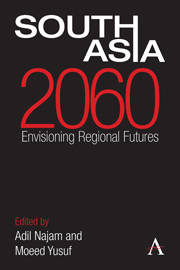Book contents
- Frontmatter
- Contents
- Acknowledgments
- List of Abbreviations
- Introduction: Imagining South Asian Futures
- Section I South Asia as a Region
- Section II State Relations
- Chapter 6 The Future of Democracy
- Chapter 7 Conflict and Reconciliation: Three Scenarios
- Chapter 8 Religion and State Formation
- Chapter 9 Will South Asia Still Be Terrorism's Center of Gravity?
- Chapter 10 Speculations on Nuclear South Asia
- Chapter 11 Nuclear Risk: Overstated or Underrated?
- Chapter 12 The Shadow of the India–Pakistan Stalemate
- Chapter 13 Regional Integration
- Chapter 14 The Future of Integration
- Chapter 15 The Giant Neighbor: Why is China Important?
- Section III Development
- Section IV Human Well-Being
- About the Authors
- Bibliography
- Index
Chapter 6 - The Future of Democracy
from Section II - State Relations
Published online by Cambridge University Press: 05 September 2013
- Frontmatter
- Contents
- Acknowledgments
- List of Abbreviations
- Introduction: Imagining South Asian Futures
- Section I South Asia as a Region
- Section II State Relations
- Chapter 6 The Future of Democracy
- Chapter 7 Conflict and Reconciliation: Three Scenarios
- Chapter 8 Religion and State Formation
- Chapter 9 Will South Asia Still Be Terrorism's Center of Gravity?
- Chapter 10 Speculations on Nuclear South Asia
- Chapter 11 Nuclear Risk: Overstated or Underrated?
- Chapter 12 The Shadow of the India–Pakistan Stalemate
- Chapter 13 Regional Integration
- Chapter 14 The Future of Integration
- Chapter 15 The Giant Neighbor: Why is China Important?
- Section III Development
- Section IV Human Well-Being
- About the Authors
- Bibliography
- Index
Summary
This paper forecasts the future of democracy in South Asia. It applies a four-step methodology: baseline definition, detection of first-order trends, identification of certainties and uncertainties and finally the construction of scenarios. The essay accordingly is divided into four main sections: each section begins with a brief description of the task, followed by an analysis of the South Asian situation. The final section provides an overall interpretation on the possible state of democracy in South Asia in 2060.
Baseline
By democracy I imply a minimalist notion – an electoral political system which gives the opposition a fair chance to win. Because our focus is on South Asia as a region, we have to “deprioritize” differences across national boundaries and distill commonalities that might form the basis of a future system. Through most of the past 50 years, the common platform across South Asia has been a Westminster-style parliamentary system, with single-member constituencies and first past the post voting. Periodic challenges to this, either presidential – in Pakistan, Sri Lanka, and the Maldives – or military-autocratic as in Bangladesh and Pakistan, or one-party rule like India and the Maldives have been precisely that: temporary challenges, which eventually gave way. Even monarchies like Nepal and Bhutan have moved toward greater parliamentary legislation.
- Type
- Chapter
- Information
- South Asia 2060Envisioning Regional Futures, pp. 55 - 60Publisher: Anthem PressPrint publication year: 2013

